The testimony of Dionysius of Halicarnassus confirms its existence. He mentioned the existence of a sanctuary dedicated to Aphrodite near the Small Theater. The period of its construction is placed at the end of the 4th and the beginning of the 3rd century BC. The orchestra, a large portion of the koilon, the area in which the audience sits, and the proscenium were discovered in 1976. Among other things, says Dionysios of Halicarnassus Pyrrhus built two theaters, one large, impressive like that of Dodona, and a smaller one, near the temple of Apollo.
«ἐν δέ Ἀμβρακία ἱερόν τε τῆς Θεοῡ ἡρὧον Αἰνείου πλησίον τοῦ μικροῦ θεάτρου, ἐν ᾢ καί ξόανον μικρόν ἀρχαϊκόν Αινείου λεγόμενον»
Διονυσίου Αλικαρνασσέως, Ρωμαϊκή Αρχαιολογία: 1.50.4
«in Ambracia, a temple of Aphroditê Aeneias and a hero-shrine of Aeneas near the little theatre»
The Roman Antiquities of Dionysius of Halicarnassus: 1.50.4
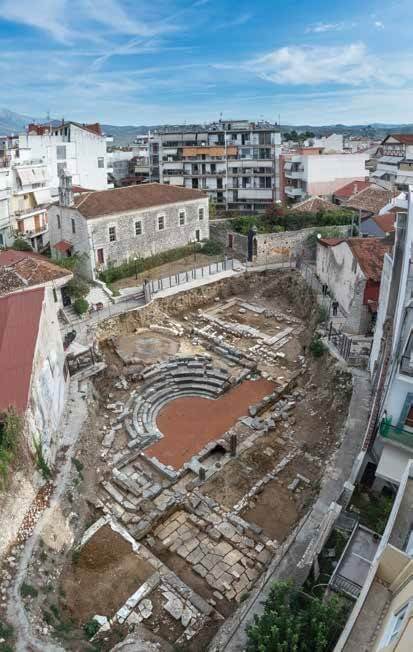
The orchestra is in the shape of a complete circle, 6,70 m. in diameter, although its floor is not preserved. The cavea is divided into three blocks of seats by two stairways and it has five rows of seats. The whole structure is flanked by two sturdy retaining walls, made of large limestone and sandstone blocks. The proedria, the honorary seats of the priesthood of Dionysus in the front row are absent. The mainstay of the proskenion has been revealed at a length of 7,5m and its facade was embellished probably with six ionic semi-columns, one of which is preserved intact and two more were found in fragmentary condition.
The most important find of the first excavation was a golden stater of Philip II, the first ancient gold coin that was discovered in Epirus. The movable finding came to light during the initial excavation of the site in 1976. It is noted that the number of bronze coins collected from the entire excavation of the Small Theater (until today) is impressive, as they exceed 250.
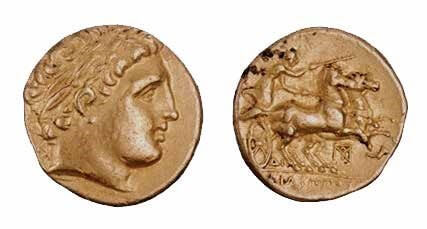
The small theater was not built on a natural hill, as is the case with other theaters, but was founded on older facilities with mosaic floors, which belong to the foundations of baths of the 4th c. B.C., as well as the foundations of buildings of the classical city.
During the first research in the ‘70s, an ancient bath was revealed underneath the koilon of the theatre. These remains belong to a relatively small infrastructure that had two rooms, which were connected with each other through openings. They retained mosaic and pebble floors made of small white and black river pebbles, depicting winged Eros Figures, swans, and dolphins, all related to water. Some of these mosaics have been detached and transferred to the Archaeological Museum of Arta.
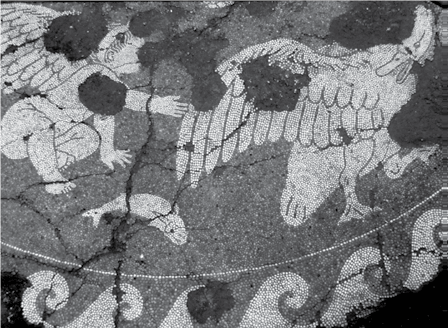
North of the Theatre is located the pebbled floor that came to light during the recent excavation in August 2018. It was part of the bath; it is circular and in the center is decorated with various depictions. The decoration includes a spiral that includes the representation, which depicts scenes of Eros Figures playing various games with swans, an Eros Figure which is riding a dolphin, a flying swan, fishes, waterfowl, and an octopus. The illustration similarity of this pebbled floor with the corresponding one that was found during the excavation of 1976 in the theater is more than obvious.
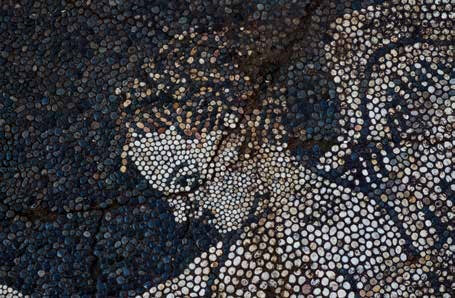
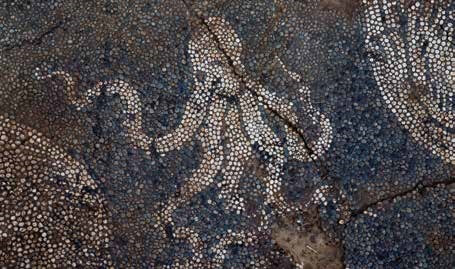
Chronological timeline
The Small Theater was built at the end of the 4th century B.C. to the early 3rd century B.C.
It remained in use until the middle of the 2nd century B.C. Over the years, the Small Theater of Ambracia was covered in turn by other buildings, Byzantine, perhaps, Ottoman, and newer.
The city numbered around 100,000 inhabitants and flourished from its foundation until the 2nd century B.C.
In 294 B.C., after forty-three years of semi-autonomy under Macedonian suzerainty, Ambracia was given by the son of Cassander to Pyrrhus, king of Epirus, who made it his capital and adorned it with a palace, temples, and theatres.
The Small Theater of Ambracia came to light in 1976, during excavations on a plot of land on Aghiou Konstantinou Street, in the center of Arta, after a few months of research on a plot of land. The archaeological research carried out at that time brought to light the largest part of the theater, which was built, according to the excavator, at the end of the 4th to the beginning of the 3rd century B.C. and remained in use until the middle of the 2nd century B.C.
From 2011 onwards, the works continue under the supervision of the Ephorate of Antiquities of Arta, within the project included in the NSRF project "Works for the Promotion and Formation of the archaeological site of the Small Theater of ancient Ambracia" (2014-2020). Unfortunately, today this archeological site remains closed to the public because the works are in progress.
Function: The Small Theater functions as an archaeological site.

